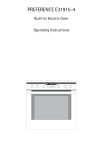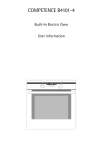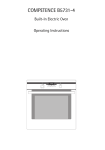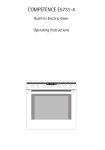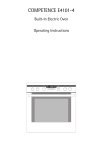Download Electrolux B3011-5 User manual
Transcript
B3011-5 User manual Built-In Electric Oven 2 Dear Customer Thank you for choosing one of our high-quality products. With this appliance you will experience the perfect combination of functional design and cutting edge technology. Convince yourself that our appliances are engineered to deliver the best performance and control - indeed we are setting the highest standards of excellence. In addition to this you find environmental and energy saving aspects as an integral part of our products. To ensure optimal and regular performance of your appliance please read this instruction manual carefully. It will enable you to navigate all processes perfectly and most efficiently. To refer to this manual any time you need to, we recommend you to keep it in a safe place. And please pass it to any future owner of the appliance. We wish you much joy with your new appliance. 3 The following symbols are used in this user manual: Important information concerning your personal safety and information on how to avoid damaging the appliance. General information and tips 2 Environmental information 1 Contents 3 Contents Operating Instructions 5 Safety instructions 5 Disposal 7 Description of the Appliance General Overview Control Panel Oven Features Oven accessories Before Using for the first time Initial Cleaning Using the Oven Switching the Oven On and Off Oven Functions Inserting the Oven Shelf and the Baking Tray Uses, Tables and Tips Baking Baking table Bakes and gratins table Frozen ready meals table Roasting Roasting table Grill sizes Grilling table Defrosting Defrosting table Drying Making preserves Cleaning and Care Outside of the appliance Oven Interior Accessories Shelf Support Rails Oven Lighting Oven door Oven door glass 8 8 9 10 11 12 12 13 13 14 15 16 16 18 21 22 23 24 26 26 27 27 28 29 31 31 31 31 32 33 34 36 4 Contents What to do if … 40 Technical Data Oven Interior Dimensions Installation Instructions Safety information for the installer Guarantee/Customer Service 41 41 42 42 45 Service 47 Operating Instructions 5 Operating Instructions 1 Safety instructions Electrical safety • This appliance must be only connected by a registered electrician. • In the event of a fault or damage to the appliance: Take the fuses out or switch off. • Repairs to the appliance must only be carried out by qualified service engineers. Considerable danger may result from improper repairs. If repairs become necessary, please contact our Customer Services or your dealer. Child Safety • Never leave children unsupervised when the appliance is in use. Safety whilst using • People (including children) who, because of their physical, sensory or mental capabilities or their inexperience or ignorance are not able to use the device safely, should not use this device without supervision or instruction by a responsible person. • This appliance is intended to be used for cooking, roasting and baking food in the home. • Take care when connecting electric appliances to sockets nearby. Do not allow connecting leads to come into contact with or to catch beneath the hot oven door. • Warning: Risk of burns! The interior of the oven becomes hot during use. • Using ingredients containing alcohol in the oven may create an alcohol-air mixture that is easily ignited. In this case, open the door carefully. Do not have embers, sparks or naked flames in the vicinity when opening the door. 3 Information on acrylamides According to the latest scientific knowledge, intensive browning of food, especially in products containing starch, can constitute a health risk due to acrylamides. Therefore we recommend cooking at the lowest possible temperatures and not browning foods too much. 6 Safety instructions How to avoid damage to the appliance • Do not line the oven with aluminium foil and do not place baking trays, pots, etc. on the oven floor, as the heat that builds up will damage the oven enamel. • Fruit juices dripping from the baking tray will leave stains, which you will not be able to remove. For very moist cakes, use a deep tray. • Do not put any strain on the oven door when open. • Never pour water directly into the oven when it is hot. This could cause damage to or discolouration of the enamel. • Rough handling, especially around the edges of the front panel, can cause the glass to break. • Do not store any flammable materials inside the oven. These could ignite when the oven is switched on. • Do not store any moist foods inside the oven. This could damage the oven enamel. 3 Note on enamel coating Changes in the colour of the oven’s enamel coating as a result of use do not affect the appliance’s suitability for normal and correct use. They therefore do not constitute a defect in the sense of the warranty law. Disposal 7 Disposal 2 Packaging material The packaging materials are environmentally friendly and can be recycled. The plastic components are identified by markings, e.g. >PE<, >PS<, etc. Please dispose of the packaging materials in the appropriate container at the community waste disposal facilities. 2 Old appliance W 1 The symbol on the product or on its packaging indicates that this product may not be treated as household waste. Instead it shall be handed over to the applicable collection point for the recycling of electrical and electronic equipment. By ensuring this product is disposed of correctly, you will help prevent potential negative consequences for the environment and human health, which could otherwise be caused by inappropriate waste handling of this product. For more detailed information about recycling of this product, please contact your local city office, your household waste disposal service or the shop where you purchased the product. Warning: So that the old appliance can no longer cause any danger, make it unusable before disposing of it. To do this, disconnect the appliance from the mains supply and remove the mains cable from the appliance. 8 Description of the Appliance Description of the Appliance General Overview Control panel Door handle Full glass door Description of the Appliance Control Panel Oven Power Indicator Oven Functions Temperature Pilot Light Temperature selector 9 10 Description of the Appliance Oven Features All interior oven walls, except the floor of the oven, are coated with a special enamel (catalytic coating). Top heat and heating elements Oven lighting Shelf positions Fan Bottom Heat Oven shelf runners, removable Inside of door You will find the shelf position number on the inside of the oven door. Description of the Appliance Oven accessories Oven shelf For cookware, cake tins, roasts and grilled foods. Baking tray For cakes and biscuits. 11 12 Before Using for the first time Before Using for the first time Initial Cleaning 1 3 You should clean the oven before using it for the first time. Caution: Do not use any caustic, abrasive cleaners! The surface could be damaged. To clean the external parts of the oven, only use a cloth well wrung out with warm water to which a little washing up liquid has been added or a commercially available cleaner specifically designed for this purpose. To prevent damaging the door or door glass, avoid the use of the following: • Household detergent and bleaches • Impregnated pads unsuitable for non-stick saucepans • Brillo/Ajax pads or steel wool pads • Chemical oven pads or aerosols • Rust removers • Bath/Sink stain removers 1. Turn the oven function switch to oven lighting . 2. Remove all accessories and the shelf support rails and wash them with warm water and washing up liquid. 3. Wash the floor of the oven in the same way using warm soapy water, and allow to dry. 4. Wipe the front of the appliance with a damp cloth. Using the Oven 13 Using the Oven 3 The oven is equipped with retractable buttons for “Oven functions” and “Temperature selection”. To use, press the relevant button. The button then sticks out. Switching the Oven On and Off Oven Power Indicator Oven Functions Temperature Pilot Light Temperature selector 1. Turn the oven functions dial to the desired function. 2. Turn the temperature selector to the desired temperature. The power indicator is lit as long as the oven is in operation. The temperature pilot light is lit as long as the oven is heating up. 3. To turn the oven off, turn the oven functions dial and the temperature selector to the Off position. 3 Cooling fan The fan switches on automatically in order to keep the appliance’s surfaces cool. When the oven is switched off, the fan continues to run to cool the appliance down, then switches itself off automatically. 14 Using the Oven Oven Functions The oven has the following functions: Oven function Application Light Using this function you can light up the oven interior, e.g. for cleaning. Fan-assisted circulation For baking on up to two oven levels. Set the oven temperatures 20-40 °C lower than when using Conventional. Conventional For baking and roasting on one oven level. Bottom heat For baking cakes with crispy or crusty bases. Defrost For defrosting e. g. flans and gateaux, butter, bread, fruit or other frozen foods. Grill For grilling flat food items placed in the middle of the grill and for toasting. Dual gril For grilling flat food items in large quantities and for toasting. Rothitherm For roasting larger joints of meat or poultry on one level. The function is also suitable for gratinating and browning. Using the Oven 15 Inserting the Oven Shelf and the Baking Tray 3 Shelf runner safety and anti-tip device As a shelf runner safety device, all insertable components have a small curved indentation at the bottom on the right and left-hand edge. Always insert insertable components so that this indentation is at the back of the oven interior. This indentation is also important for preventing the insertable components from tipping. Inserting the baking tray Push the baking tray between the guide bars of the selected oven level. 3 Inserting the oven shelf: Insert the oven shelf so that the feet point downwards. Push the oven shelf between the guide bars of the selected oven level. The high rim around the oven shelf is an additional device to prevent cookware from slipping. Inserting the oven shelf and the baking tray together: Lay the oven shelf on the baking tray. Push the baking tray between the guide bars of the selected oven level. 16 Uses, Tables and Tips Uses, Tables and Tips Baking Oven function: Fan-assisted circulation or Conventional Baking tins • For Conventional , dark metal and non-stick tins are suitable. • For Fan-assisted circulation bright metal tins are also suitable. Oven levels • Baking with Conventional is only possible on one level. • With Fan-assisted circulation you can bake dry cakes and biscuits on 2 baking trays at the same time. 1 baking tray: e.g. oven level 3 1 cake tin: e.g. oven level 1 2 baking trays: e. g. oven levels 1 and 3 Uses, Tables and Tips 3 2 17 General Instructions • Insert the tray with the bevel at the front. • With Conventional or Fan-assisted circulation you can also bake with two tins next to one another on the oven shelf at the same time. This does not significantly increase baking time. When frozen foods are used the trays inserted may distort during cooking. This is due to the large difference in temperature between the freezing temperature and the temperature in the oven. Once the trays have cooled the distortion will disappear again. How to use the Baking Tables The tables give the required temperature settings, baking times and oven shelf levels for a selection of typical dishes. • Temperatures and baking times are for guidance only, as these will depend on the consistency of pastry or mixture, the number and the type of cake tin. • We recommend using the lower temperature the first time and then if necessary, for example, if a deeper browning is required, or baking time is too long, selecting a higher temperature. • If you cannot find the settings for a particular recipe, look for the one that is most similar. • If baking cakes on baking trays or in tins on more than one level, baking time can be extended by 10-15 minutes. • Moist recipes (for example, pizzas, fruit flans, etc.) are baked on one level. • Cakes and pastries at different heights may brown at an uneven rate at first. If this occurs, please do not change the temperature setting. Different rates of browning even out as baking progresses. • Your new oven may bake or roast differently to your previous appliance. So adapt your normal settings (temperature, cooking times) and oven shelf levels to the recommendations in the following tables. With longer baking times, you can switch the oven off about 10 minutes before the end of the baking time, in order to utilise the residual heat. Unless otherwise stated, the values given in the tables assume that cooking is started with the oven cold. 18 Uses, Tables and Tips Baking table Type of baking Ovenfunction Shelf position Temperature °C Temperature °F Time Hours mins. Baking in tins Ring cake or brioche Fan-assisted circulation 1 150-160 302-320 0:50-1:10 Madeira cake/ Fruitcakes Fan-assisted circulation 1 140-160 284-320 1:10-1:30 Sponge cake Fan-assisted circulation 1 140 284 0:25-0:40 Sponge cake Conventional 1 160 320 0:25-0:40 Flan base - short pastry Conventional 3 180-200 356-392 0:10-0:25 Flan base - sponge mixture Fan-assisted circulation 3 150-170 302-338 0:20-0:25 Apple pie Conventional 1 170-190 338-190 0:50-1:00 Apple pie (2tins Ø20cm, diagonally off set) Fan-assisted circulation 1 160 320 1:10-1:30 Apple pie (2tins Ø20cm, diagonally off set) Conventional 1 180 356 1:10-1:30 Savoury flan (e. g. quiche lorraine) Conventional 1 180-200 356-392 0:30-1:10 Cheesecake Conventional 1 170-190 338-374 1:00-1:30 Uses, Tables and Tips Type of baking Ovenfunction 19 Shelf position Temperature °C Temperature °F Time Hours mins. Cakes/pastries/breads on baking trays Plaited bread/bread crown Conventional 3 170-190 338-374 0:30-0:40 Christmas stollen Conventional 3 160-1801) 320-3561) 0:40-1:00 Bread (rye bread) -first of all -then Conventional 1 2501) 160-180 4821) 320-356 0:20 0:30-1:00 Cream puffs/Eclairs Fan-assisted circulation 3 160-1701) 320-3381) 0:15-0:30 Swiss roll Conventional 3 180-2001) 356-3921) 0:10-0:20 Cake with crumble topping(dry) Fan-assisted circulation 3 150-160 302-320 0:20-0:40 Buttered almond cake/ sugar cakes Conventional 3 190-2101) 374-4101) 0:15-0:30 Fruit flans (made with yeast dough/sponge mixture) Fan-assisted circulation 3 150 302 0:35-0:50 Fruit flans (made with yeast dough/sponge mixture) Conventional 3 170 338 0:35-0:50 Fruit flans made with short pastry Conventional 3 170-190 338-374 0:40-1:20 Yeast cakes with delicate toppings (e. g. quark, cream, vanilla cream) Conventional 3 160-180 320-3561) 0:40-1:20 Pizza (with a lot of topping) Conventional 1 190-2101) 374-4101) 0:30-1:00 Pizza (thin crust) Conventional 1 230-2501) 446-4821) 0:10-0:25 Unleavened bread Conventional 1 250-270 482-518 0:08-0:15 Tarts (CH) Conventional 1 200-220 392-428 0:35-0:50 20 Uses, Tables and Tips Type of baking Ovenfunction Shelf position Temperature °C Temperature °F Time Hours mins. Biscuits Short pastry biscuits Fan-assisted circulation 3 150-160 302-320 0:06-0:20 Short pastry biscuits Fan-assisted circulation 1/3 150-160 302-320 0:06-0:20 Viennese whirls Fan-assisted circulation 3 140 284 0:20-0:30 Viennese whirls Fan-assisted circulation 1/3 140 284 0:25-0:40 Viennese whirls Conventional 3 1601) 3201) 0:20-0:30 Biscuits made with sponge mixture Fan-assisted circulation 3 150-160 302-320 0:15-0:20 Biscuits made with sponge mixture Fan-assisted circulation 1/3 150-160 302-320 0:15-0:20 Pastries made with egg white, meringues Fan-assisted circulation 3 80-100 176-212 2:00-2:30 Macaroons Fan-assisted circulation 3 100-120 212-248 0:30-0:60 Biscuits made with yeast dough Fan-assisted circulation 3 150-160 302-320 0:20-0:40 Puff pastries Fan-assisted circulation 3 170-1801) 338-3561) 0:20-0:30 Rolls Fan-assisted circulation 3 1601) 3201) 0:20-0:35 Rolls Conventional 3 1801) 3561) 0:20-0:35 2841) 0:20-0:30 Small cakes (20per tray) Fan-assisted circulation 3 1401) Small cakes (20per tray) Fan-assisted circulation 1/4 1401) 2841) 0:25-0:40 Small cakes (20per tray) Conventional 3 1701) 3381) 0:20-0:30 1) Pre-heat the oven Uses, Tables and Tips 21 Tips on baking Baking results Possible cause Remedy The cake is not browned Wrong oven level enough at the bottom Place cake lower in the oven The cake sinks (becomes soggy, lumpy, streaky) Oven temperature too high Use a slightly lower setting Baking time too short Set a longer baking time Baking times cannot be reduced by setting higher temperatures Too much liquid in the mixture Use less liquid Pay attention to mixing times, especially if using mixing machines Oven temperature too low Set oven temperature higher Baking time too long Set a shorter baking time Oven temperature too high and baking time too short Set a lower oven temperature and a longer baking time Mixture is unevenly distributed Spread the mixture evenly on the baking tray Temperature too low Use a slightly higher oven setting Cake is too dry Cake browns unevenly Cake is not done within the baking time given Bakes and gratins table Dish Oven function Shelf position Temperature °C Temperature °F Time Hours mins. Pasta bake Conventional 1 180-200 356-392 0:45-1:00 Lasagne Conventional 1 180-200 356-392 0:25-0:40 Vegetables au gratin1) Rothitherm 1 160-170 320-338 0:15-0:30 Baguettes topped with melted cheese1) Rothitherm 1 160-170 320-338 0:15-0:30 Sweet bakes Conventional 1 180-200 356-392 0:40-0:60 Fish bakes Conventional 1 180-200 356-392 0:30-1:00 Rothitherm 1 160-170 320-338 0:30-1:00 Stuffed vegetables 1) Pre-heat the oven 22 Uses, Tables and Tips Frozen ready meals table Food to be cooked Oven function Shelf position Temperature °C/°F Time Frozen pizza Conventional 3 as per manufacturer’s instructions as per manufacturer’s instructions Chips1) (300-600 g) Rothitherm 3 200-220/392-428 as per manufacturer’s instructions Baguettes Conventional 3 as per manufacturer’s instructions as per manufacturer’s instructions Fruit flans Conventional 3 as per manufacturer’s instructions as per manufacturer’s instructions 1) Comments: Turn chips 2 or 3 times during cooking Uses, Tables and Tips 23 Roasting Oven function: Conventional or Rothitherm Ovenware for roasting • Any heat-resistant ovenware is suitable to use for roasting. (Please read the manufacturer's instructions.) • For all lean meats, we recommend roasting these in a roasting tin or dish with a lid. The meat will be more succulent. • All types of meat, that can be browned or have crackling, can be roasted in a roasting tin or dish without a lid. 3 Tips on using the Roasting Table The information given in the following table is for guidance only. • We recommend cooking meat and fish weighing 1kg or more in the oven. • To prevent meat juices or fat from burning onto the ovenware, we recommend adding some liquid. • If required, turn the roast (after 1/2 - 2/3 of the cooking time). • Baste large roasts and poultry with their juices several times during roasting. This will give better roasting results. • You can switch the oven off about 10 minutes before the end of the roasting time, in order to utilise the residual heat. 24 Uses, Tables and Tips Roasting table Type of meat Quantity Ovenfunction 1-1.5 kg Conventional Shelf position Temperature °C Temperature °F Time Hours mins. 1 200-250 392-482 2:00-2:30 Beef Pot roast Roast beef or fillet per cm. of thickness - rare per cm. of thickness Rothitherm 1 190-2001) 374-3921) 0:05-0:06 - medium per cm. of thickness Rothitherm 1 180-190 356-374 0:06-0:08 - well done per cm. of thickness Rothitherm 1 170-180 338-356 0:08-0:10 Shoulder, neck, ham joint 1-1.5 kg Rothitherm 1 160-180 320-356 1:30-2:00 Chop, spare rib 1-1.5 kg Rothitherm 1 170-180 338-356 1:00-1:30 Meat loaf 750 g-1 kg Rothitherm 1 160-170 320-338 0:45-1:00 Porkknuckle (pre-cooked) 750 g-1 kg Rothitherm 1 150-170 302-338 1:30-2:00 1 kg Rothitherm 1 160-180 320-356 1:30-2:00 1.5-2 kg Rothitherm 1 160-180 320-356 2:00-2:30 Leg of lamb, roast lamb 1-1.5 kg Rothitherm 1 150-170 302-338 1:15-2:00 Saddle of lamb 1-1.5 kg Rothitherm 1 160-180 320-356 1:00-1:30 Saddle of hare, leg of hare up to 1 kg Conventional 3 220-2501) 428-4821) 0:25-0:40 Saddle of venison 1.5-2 kg Conventional 1 210-220 410-428 1:15-1:45 Haunch of venison 1.5-2 kg Conventional 1 200-210 392-410 1:30-2:15 Pork Veal Roast veal Knuckle of veal Lamb Game Uses, Tables and Tips Type of meat Quantity Ovenfunction 25 Shelf position Temperature °C Temperature °F Time Hours mins. Poultry Poultry portions 200-250g each Rothitherm 1 200-220 392-428 0:35-0:50 Half chicken 400-500g each Rothitherm 1 190-210 374-410 0:35-0:50 Chicken, poulard 1-1.5 kg Rothitherm 1 190-210 374-410 0:45-1:15 Duck 1.5-2 kg Rothitherm 1 180-200 356-392 1:15-1:45 Goose 3.5-5 kg Rothitherm 1 160-180 320-356 2:30-3:30 Turkey 2.5-3.5 kg Rothitherm 1 160-180 320-356 1:45-2:30 Turkey 4-6 kg Rothitherm 1 140-160 284-320 2:30-4:00 1-1.5 kg Conventional 1 210-220 410-428 0:45-1:15 Fish (steamed) Whole fish 1) Pre-heat the oven 26 Uses, Tables and Tips Grill sizes 1 3 Oven function: Grill or Dual gril with maximum temperature setting Important: Always grill with the oven door closed. The empty oven should always be pre-heated with the grill functions for 5 minutes. • For grilling, place the shelf in the recommended shelf position. • Always insert the tray into the first shelf position from the bottom. • The grilling times are guidelines. • Grilling is particularly suitable for flat pieces of meat or fish. Grilling table Food to be grilled Oven level Grilling time 1st side 2nd side Burgers 4 8-10 mins. 6-8 mins. Pork fillet 4 10-12 mins. 6-10 mins. Sausages 4 8-10 mins. 6-8 mins. Fillet steaks, veal steaks 4 6-7 mins. 5-6 mins. Fillet of beef, roast beef (approx. 1 kg) 3 10-12 mins. 10-12 mins. Toast1) 3 4-6 mins. 3-5 mins. Toast with topping 3 6-8 mins. --- 1) Do not pre-heat Uses, Tables and Tips 27 Defrosting Oven function: Defrost (no temperature setting) • Unwrap the food and place it on a plate on the oven shelf. • Do not cover with a plate or bowl, as these can substantially lengthen the defrosting time. • For defrosting, place the shelf in the 1st oven level from the bottom. Defrosting table Defrosting time mins. Further defrosting time (mins.) Chicken, 1000 g 100-140 20-30 Place the chicken on an upturned saucer placed on a large plate Turn halfway through Meat, 1000 g 100-140 20-30 Turn halfway through Meat, 500 g 90-120 20-30 Turn halfway through Trout, 150g 25-35 10-15 --- Strawberries, 300g 30-40 10-20 --- Butter, 250g 30-40 10-15 --- Cream, 2 x 200g 80-100 10-15 Cream can also be whipped when still slightly frozen in places Gateau, 1400g 60 60 Dish Comments --- 28 Uses, Tables and Tips Drying Oven function: Fan-assisted circulation • Use oven shelves covered with greaseproof paper or baking parchment. • You get a better result if you switch the oven off halfway through the drying time, open the door and leave the oven to cool down overnight. • After this, finish drying the food to be dried. Food to be dried Oven level Temperature in °C Temperature in °F 1 level 2 levels Time in hours (Guideline) Beans 60-70 140-158 3 1/4 6-8 Peppers (strips) 60-70 140-158 3 1/4 5-6 Vegetables for soup 60-70 140-158 3 1/4 5-6 Mushrooms 50-60 122-140 3 1/4 6-8 Herbs 40-50 104-122 3 1/4 2-3 Plums 60-70 140-158 3 1/4 8-10 Apricots 60-70 140-158 3 1/4 8-10 Apple slices 60-70 140-158 3 1/4 6-8 Pears 60-70 140-158 3 1/4 6-9 Vegetables Fruit Uses, Tables and Tips 29 Making preserves Oven function: Bottom heat • For preserving, use only commercially available preserve jars of the same size. • Jars with twist-off or bayonet type lids and metal tins are not suitable. • When making preserves, the first shelf position from the bottom is the one most used. • Use the shelf for making preserves. There is enough room on this for up to six 1-litre preserving jars. • The jars should all be filled to the same level and clamped shut. • Place the jars on the baking tray in such a way that they are not touching each other. • Pour approx. 1/2 litre of water into the baking tray so that sufficient moisture is produced in the oven. • As soon as the liquid starts to pearl in the first jars (after about 35-60 minutes with 1 litre jars), switch the oven off or reduce the temperature to 100°C (see table). 30 Uses, Tables and Tips Preserves table The times and temperatures for making preserves are for guidance only. Temperature in°C Temperature in°F Cooking time until simmering in mins. Continue to cook at 100°C in mins. Strawberries, blueberries, raspberries, ripe gooseberries 160-170 320-338 35-45 --- Unripe gooseberries 160-170 320-338 35-45 10-15 160-170 320-338 35-45 10-15 Carrots1) 160-170 320-338 50-60 5-10 Mushrooms1) 160-170 320-338 40-60 10-15 Cucumbers 160-170 320-338 50-60 --- Mixed pickles 160-170 320-338 50-60 15 Kohlrabi, peas, asparagus 160-170 320-338 50-60 15-20 Beans 160-170 320-338 50-60 --- Preserve Soft fruit Stone fruit Pears, quinces, plums Vegetables 1) Leave standing in oven when switched off Cleaning and Care 31 Cleaning and Care 1 Warning: First switch off the appliance and let it cool down before carrying out any cleaning. Warning: For safety reasons, do not clean the appliance with steam blasters or highpressure cleaners. Attention: Do not use any corrosive cleaning fluids, sharp objects or stain removers. Do not clean the glass oven door with abrasive fluids or metal scrapers, which could scratch the surface. The glass could crack and shatter. Outside of the appliance • Wipe the front of the appliance with a soft cloth and a solution of hot water and washing up liquid. • For metal fronts, use normal commercially available cleaning agents. • Please do not use scouring agents and abrasive sponges. Oven Interior 1 3 1. 2. 3. 4. 5. Oven lighting You can switch on the oven light to make cleaning easier. Cleaning The walls that have a catalytic coating are self-cleaning. They absorb splashes of fat while the oven is in use. To support this self-cleaning process, we recommend heating the oven without any food at regular intervals. Remove all slide-in items from the oven. Wash the oven floor with warm water and washing up liquid, then dry it. Set the oven temperature to 250 °C. Switch the oven off after one hour. Wipe off any remaining soiling with a soft damp sponge. Important! Do not use oven sprays or abrasive cleaners. Do not use soap or other cleaning agents. Doing so can damage the catalytic surface. Over time the catalytic coating can discolour slightly. This does not affect its catalytic properties. Accessories Wash all slide-in units (shelf unit, baking tray, shelf support rails etc.) after each use and dry well. Soak briefly to make them easier to clean. 32 Cleaning and Care Shelf Support Rails The shelf support rails on the left and right hand sides of the oven can be removed for cleaning the side walls. Removing the shelf support rails First pull the front of the rail away from the oven wall (1) and then unhitch at the back (2). 3 Fitting the shelf support rails Important! The rounded ends of the guide rails must be pointing forwards! To re-insert, first hook the rail into place at the back (1) and then insert the front and press into place (2). Cleaning and Care Oven Lighting 1 3 Warning: Risk of electric shock! Prior to changing the oven light bulb: – Switch off the oven! – Disconnect from the electricity supply. Place a cloth on the oven floor to protect the oven light and glass cover. Changing the oven light bulb/cleaning the glass cover 1. Remove the glass cover by turning it anticlockwise and then clean it. 2. If necessary: replace with 25 watt, 230 V, 300 °C heat-resistant oven lighting. 3. Refit the glass cover. 33 34 Cleaning and Care Oven door For easier cleaning of the oven interior the oven door of your appliance can be taken off its hinges. Removing the oven door from its hinges 1. Open the oven door as far as it will go. 2. Undo the clamping levers (A) on both door hinges fully. 3. Close the oven door as far as the first position (approx. 45°). 3 4. Take hold of the oven door with a hand on each side and pull it away from the oven at an upwards angle (Take care: It is heavy). Lay the oven door with the outer side facing downwards on something soft and level, for example, a blanket in order to prevent scratches. Cleaning and Care Hanging the oven door back on its hinges 1. From the handle side take hold of the oven door with a hand on each side and hold at an angle of approx. 45°. Position the recesses on the bottom of the oven door on the hinges on the oven. Let the door slide down as far as it will go. 2. Open the oven door as far as it will go. 3. Fold up the clamping levers (A) on both door hinges back into their original positions. 4. Close the oven door. 35 36 Cleaning and Care Oven door glass 1 The oven door is fitted with three panels of glass mounted one behind the other.The inner panels can be removed for cleaning. Important! Rough handling, especially around the edges of the front panel, can cause the glass to break. Removing the door glass panels 1. Open the oven door as far as it will go. 2. Undo the clamping levers (A) on both door hinges fully 3. Close the oven door as far as the first position (approx. 45°). Cleaning and Care 4. Take hold of the door trim(B) on the upper edge of the door at both sides and press inwards to release the clip seal. Then remove the door trim by pulling it upwards. 5. Take hold of the door glass panels on their upper edge one after the other and take them out of the guide by pulling them upwards.. 3 Cleaning the door glass panels Clean the door glass panels thoroughly with a solution of water and washing up liquid. Then dry them carefully Putting the door glass panels back. 1. From above insert the door glass panels at an angle into the door profile at the bottom edge of the door one after the other and lower them. Insert the smaller panel first, then the larger panel. 37 38 Cleaning and Care 2. Take hold of the door trim (B) at each side, position it on the inside edge of the door and plug the door trim (B) into the upper edge of the door 3 On the open side of the door trim (B) there is a guide bar (C). This must be pushed between the outer door panel and the guide corner (D). The clip seal (E) must be snapped in. Cleaning and Care 3. Open the oven door as far as it will go. 4. Fold up the clamping levers (A) on both door hinges back into their original positions 5. Close the oven door. 39 40 What to do if … What to do if … Fault The oven does not heat. Possible cause Remedy The oven has not been switched on. Switch the oven on. The required settings have not Check the settings. been made. The domestic electrical protec- Check the fuses or protection tion device (fuse) has been devices. tripped. If these are tripped repeatedly, you should call a qualified electrician. The oven light does not come on. 1 3 3 The bulb has blown. Replace the bulb. If you are unable to remedy the problem by following the above suggestions, please contact your local Service Force Centre. Warning! Repairs to the appliance are only to be carried out by qualified service engineers. Considerable danger to the user may result from improper repairs. If the appliance has been operated incorrectly, the engineer's visit will be chargeable, even during the warranty period. Advice on cookers with metal fronts: Because of the cold surface at the front of the cooker, opening the oven door during (or just after) baking or roasting may cause the glass to steam up. Technical Data 41 Technical Data Oven Interior Dimensions Height x Width x Depth Capacity (usable capacity) 31,0 cm x 40,5 cm x 41,0 cm 51 l Regulations, Standards, Directives This appliance meets the following standards: • IEC 60 335-1 and IEC 60 335-2-6 relating to the safety of electric appliances for household use and similar purposes and • IEC 60350 relating to the operating features of household electric cookers. Voltage of mains supply 208V 240V Oven mode: Hot Air Rated Power Measured Power Temperature rise 1680 Watt 155 K 2250 Watt 155 K Oven mode: Top Bottom Rated Power Measured Power Temperature rise 1630 Watt 180 K 2200 Watt 180 K 42 Installation Instructions Installation Instructions 1 1 Attention: The new appliance may only be installed and connected by a registered expert. Please comply with this. If you do not, any damage resulting is not covered by the warranty. Safety information for the installer • The electrical installation is to be set up so that the appliance can be isolated from the mains with a minimum 3mm all-pole contact separation. Suitable separation devices include e.g. cut-outs, fuses (screw fuses are to be taken out of the holder), RCD’s and contactors. • Anti-shock protection must be provided by the installation. • The built-in unit must meet the stability requirements of DIN 68930. Installation Instructions 43 Connect the Armour Cable into the junction box, and connect the wires according to National and Local electrical codes. 44 Installation Instructions Guarantee/Customer Service 45 Guarantee/Customer Service EURO-LINE APPLIANCES LENGTH OF WARRANTY: TWO YEAR FULL WARRANTY from original date of purchase, including parts and labour, to the first purchaser of this appliance EURO-LINE WILL PAY FOR: Replacement parts and/or labour to repair defects in materials or workmanship. Service must be provided by an authorized Euro-Line company (unless advised otherwise). THIS GUARANTEE DOES NOT COVER COMMERCIAL USE. The name Euro-Line Appliances, for service matters, incorporates work performed by authorized service agents or service companies. EXCEPTIONS: EURO-LINE APPLIANCES WILL NOT PAY FOR THE FOLLOWING SERVICE CALLS: 1. To install or correct the installation of an appliance 2. To instruct the use of an appliance. 3. To replace house fuses, re-set circuit breakers or correct house wiring. 4. To correct house plumbing. 5. To clean drains, filters or garbage disposers. 6. To repair an appliance if it fails due to misuse or abuse. EURO-LINE APPLIANCES WILL NOT PAY WHEN THE FOLLOWING OCCURS: 1. Damage resulting from fires, acts of God, alteration, improper installation, or installation not in accordance with local building codes. 2. Pickup or delivery of major appliances requiring service. The appliances are designed to be repaired in the home. However, Euro-Line will not be responsible for travelling and labour costs if the customer lives in excess of 50 km/30 miles, or if the travel time is in excess of 30 minutes from the nearest service center. Any excess to this will not be covered by the warranty. In no event, will Euro-Line be responsible for incidental or consequential damages. For warranty service and parts, contact EURO-PARTS. Service will be provided during normal business hours. Should you have a service problem that is not resolved locally, contact: For Service and Parts Contact: EURO-PARTS, USA EURO-PARTS, CANADA Tel: 1-800-561-4614 Tel: 1-800-678-8352 Fax: 1-519-528-5001 Fax: 1-519-528 5001 EURO-LINE APPLIANCES 1-800-421-6332 Tel. Direct: 1-905-829-3980 Fax: 1-905-829-3985 46 Guarantee/Customer Service User Instructions & Installation Manual Service & Repair To save you time and money please have the following information ready in case you have to call for service: • Name of the dealer from whom you purchased the appliance. _______________________________________________ • Model number (shown on the rating plate) _______________________________________________ • Serial number (shown on the rating plate) _______________________________________________ • Date of purchase. _______________________________________________ You should also retain the original purchase receipt to support any claim made under the warranty. (We suggest you staple the receipt to this page). If service is required, contact the Service Center: EURO-PARTS, CANADA Tel: 1 800 678 8352 Fax: 1-519-528-500 EURO-PARTS, USA Tel: 1-800-561-4614 Fax: 1-519-528-5001 DISTRIBUTED BY: EURO-LINE APPLIANCES 2150 WINSTON PARK DRIVE, UNIT #20 OAKVILLE, ONTARIO CANADA L6H 5V1 1-800-421-6332 Tel: 905-829-3980 Fax: 905-829-3985 www.euro-line-appliances.com Service 47 Service In the event of technical faults, please first check whether you can remedy the problem yourself with the help of the operating instructions (section “What to do if…”). If you were not able to remedy the problem yourself, please contact the Customer Care Department or one of our service partners. In order to be able to assist you quickly, we require the following information: – Model description – Product number (PNC) – Serial number (S No.) (for numbers see rating plate) – Type of fault – Any error messages displayed by the appliance So that you have the necessary reference numbers from your appliance at hand, we recommend that you write them in here: Model description: ..................................... PNC: ..................................... S No: ..................................... 822 720 039-N-060508-02 Subject to change without notice www.electrolux.com


















































